Please use this identifier to cite or link to this item:
https://hdl.handle.net/11147/3394Full metadata record
| DC Field | Value | Language |
|---|---|---|
| dc.contributor.advisor | Erkarslan, Önder | en |
| dc.contributor.author | Erinçkan, Aykut | - |
| dc.date.accessioned | 2014-07-22T13:51:27Z | - |
| dc.date.available | 2014-07-22T13:51:27Z | - |
| dc.date.issued | 2009 | en |
| dc.identifier.uri | http://hdl.handle.net/11147/3394 | - |
| dc.description | Thesis (Master)--Izmir Institute of Technology, Industrial Design, Izmir, 2009 | en |
| dc.description | Includes bibliographical references (leaves: 75-77) | en |
| dc.description | Text in English; Abstract: Turkish and English | en |
| dc.description | xi, 81 leaves | en |
| dc.description.abstract | Changing economic conditions and rapid industrial changes have reshaped social structures and closely affected the process of urbanization. With the impact of capitalism, social classes have become more evident. This situation have played important role on the development of modern cities. Lifestyles, enjoyments and likes of social classes have become influential on their habits of consumption. They started to behave in a way required by their social classes in which they are and expect from a product what their social class requires them to do. While people used to live with the other members of the family in large and comfortable places altogether in the past, social conditions have forced them to live in smaller and more practical places recently. Being smaller, their living environment has affected their choice of products ads in choosing the products, features of products that are far away from floweriness and effulgence but more practical, economical; in other words, that comply with specific designing criteria have been fore grounded. The products with these designing features that meet these demands are much more preferred.The aim of this dissertation is to show how the preferences of the consumers are shaped by their social classes and lifestyles and what designing features is foreground while buying any product. While doing this, brand name called IKEA and its products are studied as a sample case. A survey is conducted in order to determine the preferences of IKEA.s customers. The dissertation consists of five chapters. Keywords: Life Styles, Furniture Design, Ikea Concept, Social Classes. | en |
| dc.language.iso | en | en_US |
| dc.publisher | Izmir Institute of Technology | en |
| dc.rights | info:eu-repo/semantics/openAccess | en_US |
| dc.subject.lcc | TS886.5.C45. E68 2009 | en |
| dc.subject.lcsh | Furniture design | en |
| dc.subject.lcsh | Lifestyles | en |
| dc.subject.lcsh | Social classes | en |
| dc.title | The interactions between life styles, expectations and furniture design: Case study on IKEA | en_US |
| dc.type | Master Thesis | en_US |
| dc.institutionauthor | Erinçkan, Aykut | - |
| dc.department | Thesis (Master)--İzmir Institute of Technology, Industrial Design | en_US |
| dc.relation.publicationcategory | Tez | en_US |
| item.languageiso639-1 | en | - |
| item.fulltext | With Fulltext | - |
| item.openairecristype | http://purl.org/coar/resource_type/c_18cf | - |
| item.openairetype | Master Thesis | - |
| item.grantfulltext | open | - |
| item.cerifentitytype | Publications | - |
| Appears in Collections: | Master Degree / Yüksek Lisans Tezleri Sürdürülebilir Yeşil Kampüs Koleksiyonu / Sustainable Green Campus Collection | |
Files in This Item:
| File | Description | Size | Format | |
|---|---|---|---|---|
| T000236.pdf | MasterThesis | 2.37 MB | Adobe PDF |  View/Open |
CORE Recommender
Page view(s)
218
checked on Jul 22, 2024
Download(s)
440
checked on Jul 22, 2024
Google ScholarTM
Check
Items in GCRIS Repository are protected by copyright, with all rights reserved, unless otherwise indicated.